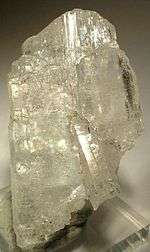Sellaite
Sellaite is a magnesium fluoride mineral with the formula MgF2. It crystallizes in the tetragonal crystal system typically as clear to white vitreous prisms. It may be fibrous and occur as radiating aggregates. It has a Mohs hardness of 5 to 6 and a specific gravity of 2.97 to 3.15. Refractive index values are nω = 1.378 and nε = 1.390.
| Sellaite | |
|---|---|
 Sellaite crystal from Serra das Éguas, Brazil (size: 4.2 x 2.4 x 2 cm) | |
| General | |
| Category | Halide mineral |
| Formula (repeating unit) | MgF2 |
| Strunz classification | 3.AB.15 |
| Crystal system | Tetragonal |
| Crystal class | Ditetragonal dipyramidal (4/mmm) H-M symbol: (4/m 2/m 2/m) |
| Space group | P42/mnm |
| Unit cell | a = 4.6213(2) c = 3.0519(1) [Å]; Z = 2 |
| Identification | |
| Color | Colorless to white |
| Crystal habit | Prismatic crystals; fibrous, radial, spherulitic |
| Twinning | On {011} |
| Cleavage | Perfect on {010} and {110} |
| Fracture | Conchoidal |
| Tenacity | Brittle |
| Mohs scale hardness | 5–5.5 |
| Luster | Vitreous |
| Diaphaneity | Transparent |
| Specific gravity | 3.15 |
| Optical properties | Uniaxial (+) |
| Refractive index | nω = 1.378 nε = 1.390 |
| Birefringence | δ = 0.012 |
| References | [1][2][3] |
Discovery and occurrence
It was first described in 1868 and named for Italian mining engineer and mineralogist Quintino Sella (1827–1884). The type locality is Gébroulaz glacier, Val Thorens, Savoie, Rhône-Alpes, France. At its type locality, sellaite occurred within a bitumen bearing dolomite-anhydrite clasts within a moraine deposit.[1][2]
It has been reported from Bleicherode, Thuringia, Germany, where it occurs in an evaporite deposit. in Vesuvius, Italy, it occurs within volcanic ejecta and fumaroles. In Serra das Éguas, Brazil, sellaite occurs in a magnesite deposit that has been metamorphosed. Near Lake Gjerdingen, Nordmarka, Oppland, Norway, it occurs in an sodic alkali granite.[1][2]
References
- Palache, C., H. Berman, and C. Frondel (1951) Dana’s system of mineralogy, (7th edition), v. II, pp. 37–39